28 June 2008, 20:42
MJinesSengwa Research Elephant Hunt/Charlton McCallum Safaris (June 2008)
Dates: June 5 - June 19Area: Sengwa Research, Zimbabwe
Outfitter: Charlton McCallum Safaris
Professional Hunter: Buzz Charlton
Trophy Focus: Elephant
Rifle Used: Merkel .500 NE
Cigars: Rocky Patel Vintage 1992, Thompson Tuskers, Macanudo Duke of York
Whiskey: Makers Mark
Beer: Castle Lager (Cold)
General Background:
This was my second safari for elephant and the second safari with Buzz.
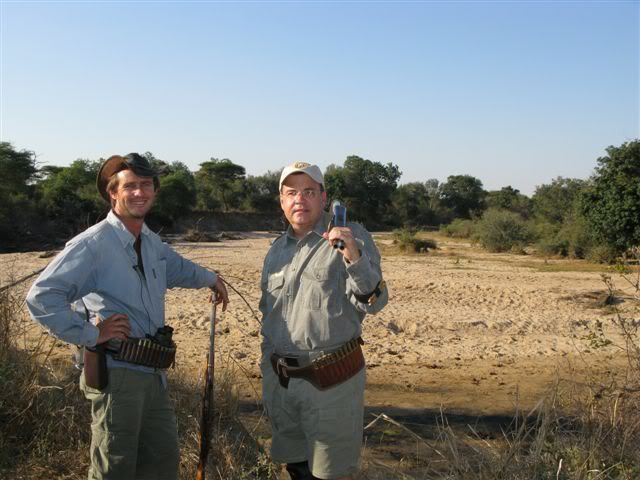
I was accompanied by a friend, Bill Clayton, who was on his first safari and will be filing a separate hunting report detailing his observations. The area we were hunting adjoins the Chirisa safari area in Western Zimbabwe. Both Chirisa and Sengwa are in the same area as Chizarira National Park. Sengwa Research is bisected by both the Sengwa and Lutope Rivers. The area has a diverse habitat consisting of riverine, vleis, mopane woodlands and thick jesse. There are a number of high bluffs that provide commanding views of the area and are excellent for spotting.
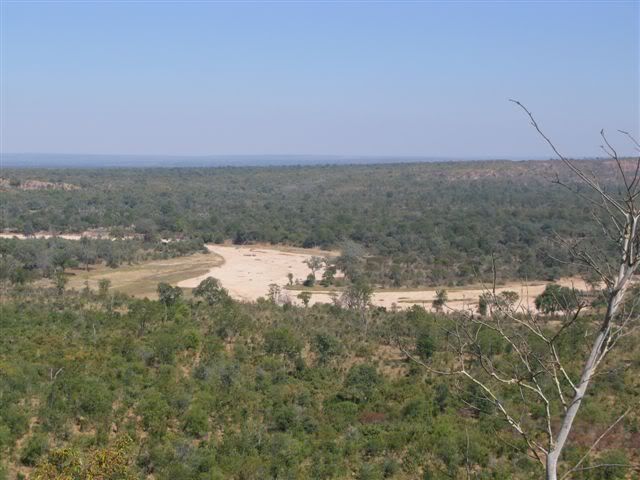
Our camp was nice -- non-traditional -- but nice. The Sengwa Research area is controlled presently by HHK Safaris. While they are in the process of securing the necessary approvals to build a more traditional tented camp, the present camp is a farmhouse-type structure that was part of the research center at Sengwa. The farmhouse was very comfortable with four separate bedrooms each with its own ensuite bathroom and shower.
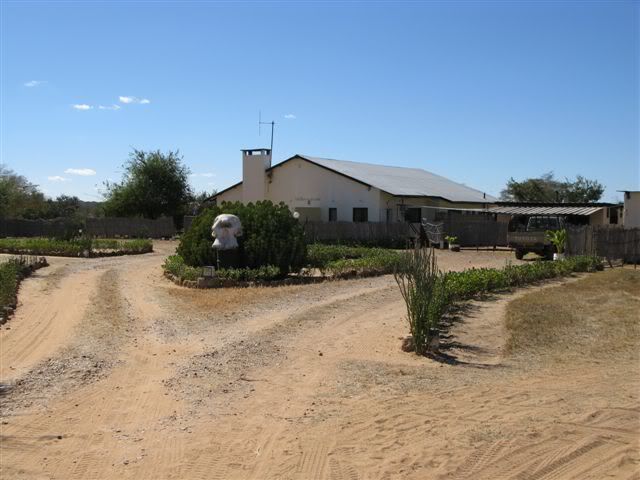
There was a nice brai and fire pit area overlooking the Sengwa River for sundowners in the evening.
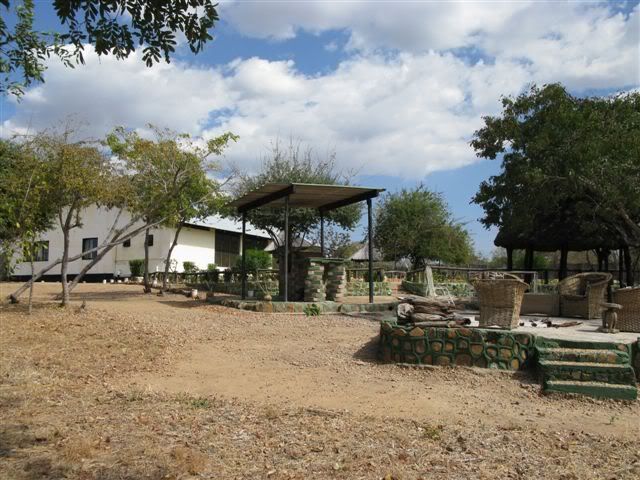
Future hunters in Sengwa Research will be staying in a tented camp up the river a bit as soon as HHK has secured the necessary environmental approvals. The camp staff was wonderful, particularly the Madala waiter who was as nice a person as you could ever hope to meet.
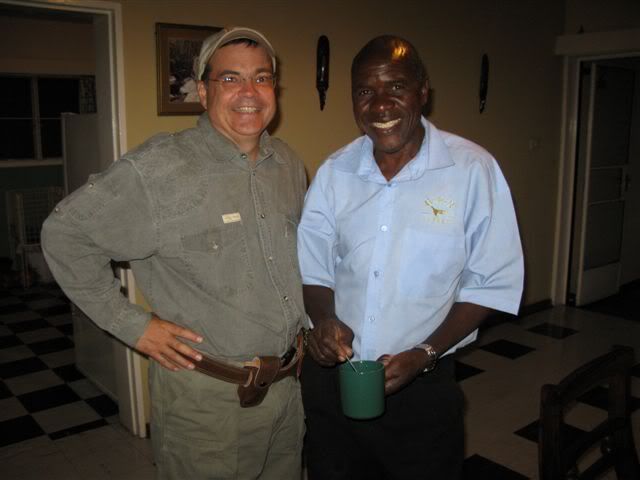
Despite all the noise about the political situation in Zimbabwe and unfounded concerns about safety, we experienced not a single issue on our trip. We chartered into camp and drove out of camp.
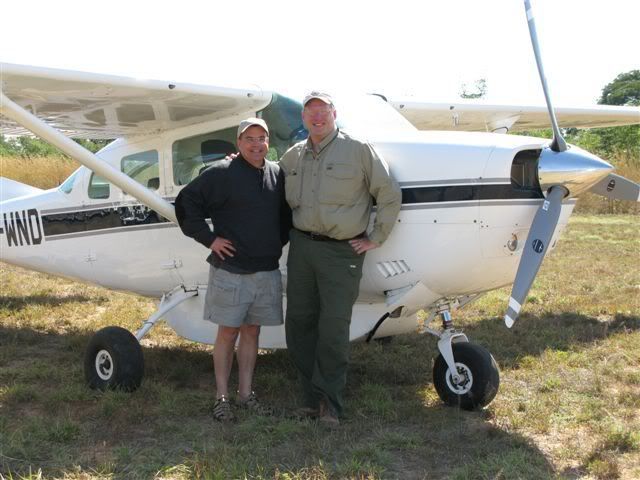
The drive out was approximately seven hours to Harare and while we passed through five roadblocks, most we were simply waved through and those that we were not waved through they just chatted for a minute and let us go.
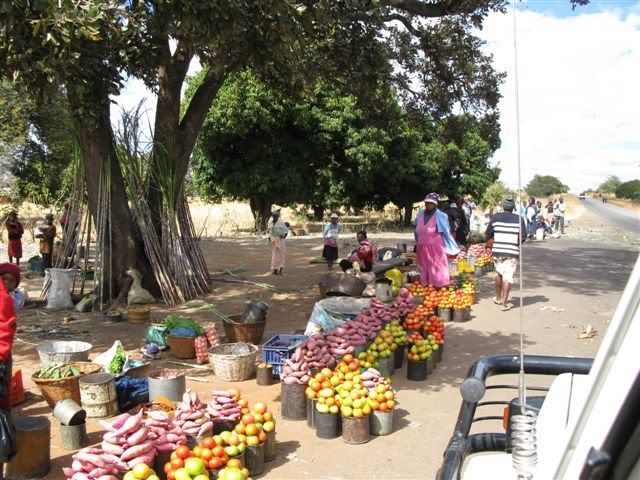
After our safari we spent a day shopping in Harare and again experienced no problems or issues. While we did observe ZANU PF party loyalists wearing t-shirts and headbands along the roads and in the city, all were simply going about their business.
Sengwa Research was at one time -- and hopefully will be again one day -- one of, if not the, largest wildlife research center in Zimbabwe. The ranger station is filled with books, specimen jars, and skull and horn specimens that were accumulated over many years.
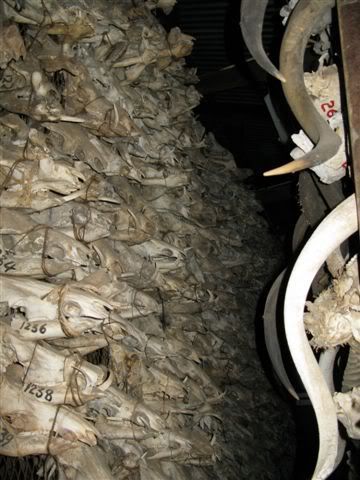
Regretfully it is clear that nothing has been done with these research materials for some time. The warden and his staff were helpful and friendly as has been the case in all my prior dealings with National Parks.
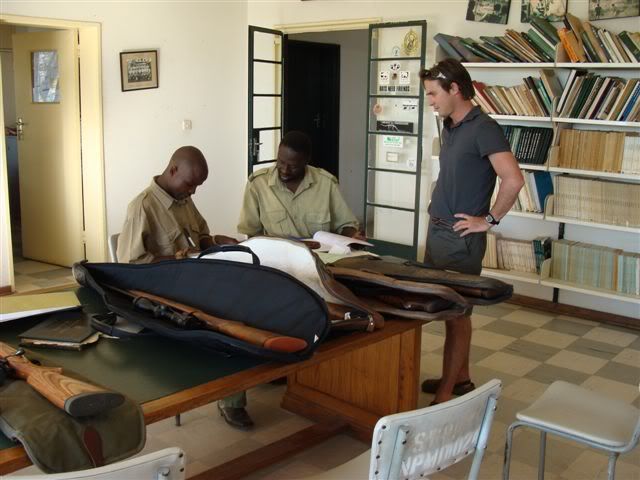
The focus of our hunt was elephant. My intention was to take a bull and a tuskless cow. For reasons I will describe below, we ended up taking five elephant in a once in a lifetime hunt. Our hunting techniques varied between spotting and stalking from the high bluffs to traditional tracking.
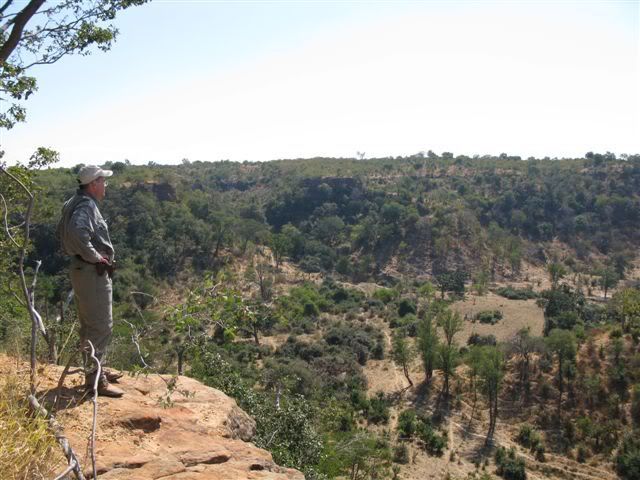
Even for the elephants that we spotting from bluffs significant tracking was still involved. Buzz's tracker, Criton, did an exceptional job under frequently tough circumstances.
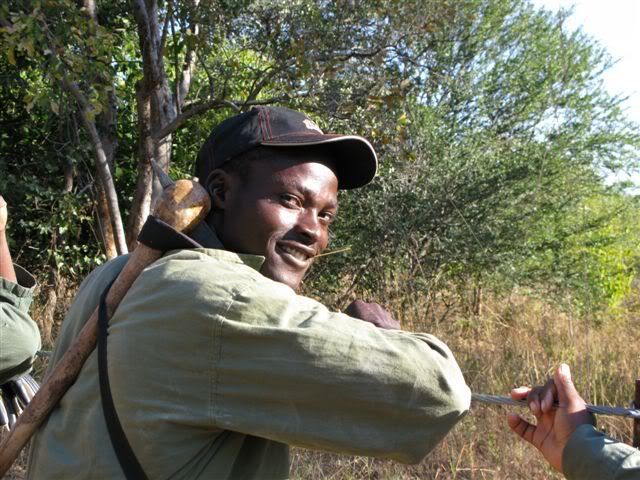
The tracking was difficult in many areas because of a combination of (i) large areas of dead grass that made finding tracks or staying on tracks difficult, and (ii) the shear number of elephant in the area. We would often have the tracks of the elephant we were following wiped out or lost by another herd that had moved in with or over the group we were tracking. All that said, Criton did a fabulous job and was able to hold tracks that any other tracker would have lost.
Elephant 1:
Our first elephant ended up being a cow that had been spotted in the area and appeared to have been wounded by poachers. The situation was reported to National Parks and approval was obtained to put the animal down if she was in fact injured. A member of the warden's staff accompanied us on the hunt to make the call on the extent of the cow's injuries.
As in most tracking situations we began tracking at road in the vicinity of where the cow had last been spotted. We tracked the cow for approximately an hour. During the course of our tracking we rounded some brush and found the cow in front of us slightly to our left staring down at us from a small incline. It was clear that her right front leg was injured and the warden's representative gave us the go ahead to take the cow.
Buzz and I began a slow walk towards the cow. As we got closer to the cow, she lowered her head and began a charge. I fired the .500 and the cow immediately went down six paces in front of us. Upon approaching the cow we determined that the cow had not been brained. My shot was actually high and to the right missing the brain but obviously knocking the cow out cold. We administered a finishing shot to the back of the cow’s head.
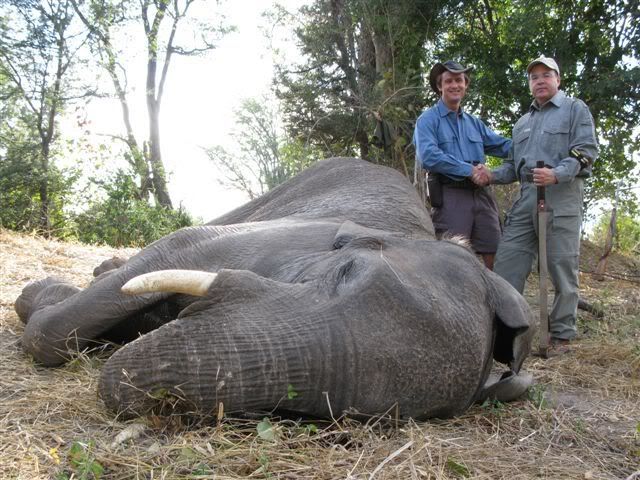
Inspection of the cow during the recovery process was a sad experience indeed. The cow was clearly in great misery from a number of gunshots from either AK47's or SKS carbines. There were at least five old bullet wounds none of which had penetrated appreciably (we found bullet fragments under the hide suggesting that the bullets used had been soft points) but all of which were suppurating. I was glad that we had been able to bring her suffering to an end and couple that with a memorable hunting experience.
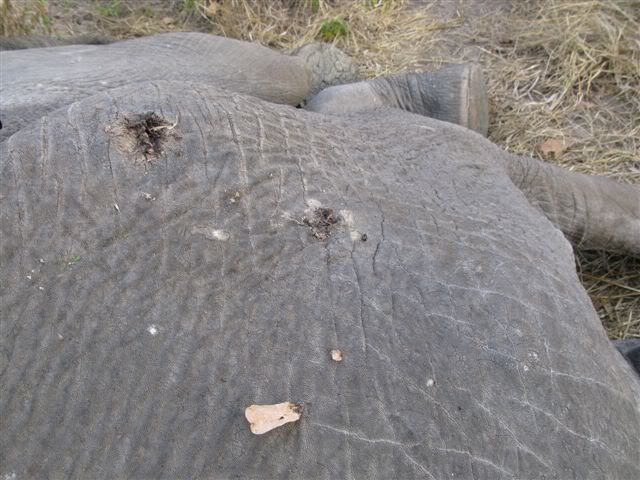
Elephant 2:
Our second elephant turned out to be our tuskless. I am particularly proud of this elephant for a couple of reasons. One, I spotted it. Two, the hunting conditions were, shall I say, interesting.
One afternoon we decided to have lunch on one of the high hill tops overlooking the Lutope and Sengwa Rivers. After lunch our group retired for the typical 30 minute nap associated with cold box lunches in the field. I have always maintained that I have plenty of time for naps when I get home and rarely use my limited time in Africa for napping. So while the group was resting I went out on a point to just spot and look around. While spotting along the river I noticed that a group of elephant were moving into a vlei (a vlei is a grassy area along a river where the grass can be thick and quite tall). As I continued to watch, more and more elephant were pouring into the vlei. At that point, I summoned the team to come take a look. We watched in amazement as literally ten, twenty, thirty, forty, and so on, elephant poured into the vlei. While we could not really tell what exactly the elephant were in the vlei (bulls, tuskless, etc.) we knew we needed to take a closer look. By the time we headed down to look the herd(s) over, there were literally over a hundred elephant feeding in the vlei.
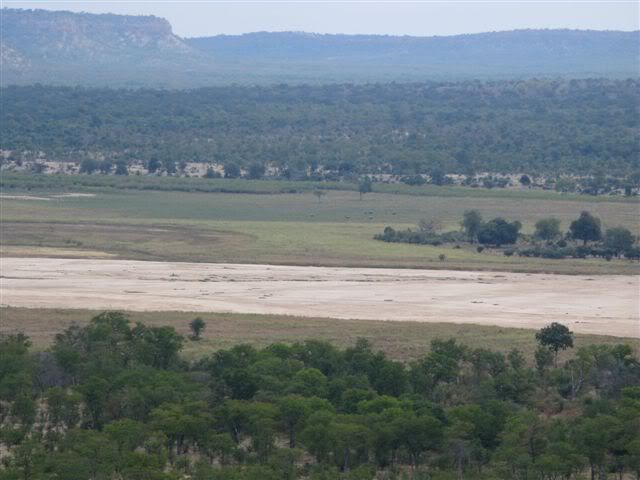
As we approached the vlei we identified a tuskless that was somewhat separated from the other groups. She did not have a dependant calf and we elected to make a stalk on her. Walking through the vlei was an interesting, un-nerving and adrenalin-pumping experience. As noted above, the grass is very tall making visibility over the grass difficult. Because the area is along the river there are many holes where elephant have stepped when the area was muddy. Finally, the grass is very thick so it is difficult to see around you. Couple this with the fact that there are a number of other elephant milling around and you can begin to see what I mean about it being an interesting, un-nerving and adrenalin-pumping experience. I am afraid my head looked a bit like a bobble-head doll trying to look around 360° to see what was around us.
Moving in on the cow she eventually became aware of our presence and spun around to face us. As she was spinning around I fired a quartering on side brain shot and she dropped dead instantly 12 paces from where we stood. Her momentum carried her in virtually a full circle from where she had been standing when she first spotted us. At the shot, the other elephant in the vlei began running in our direction. Buzz shouted, “Follow me, let’s get on the back of the cowâ€. As we began running toward the cow, first Buzz, then I, both stepped in a hole and stumbled. It makes for some comical video in retrospect. By the time we reached the cow, the other elephant had shifted around and were moving away, thankfully.
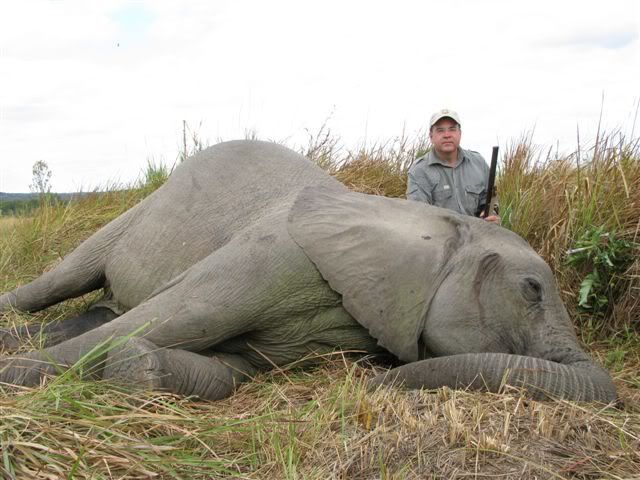
The only person in our group that smoked was our videographer, Justin Drainer (who is an excellent cameraman and whose courage I admire since he is holding a camera, not a rifle like the rest of us). Other than cigars in the evenings, I am not a smoker. However, the first thing I did once the situation was stable was to ask Justin for a cigarette!
From the picture you can get a sense of the height of the grass. You can also see from the cow’s chest and the staining on her chest that the herd was obviously spending considerable time feeding in the vlei.
Elephant 3:
One afternoon we received a radio call that the warden had indicated that National Parks wanted at least one, possibly two, elephants for rations. Of course, we responded that we would be more than happy to assist. As fate would have it, the call came in as we were tracking a group of cows in a mopane woodlands area.
The cows were aware that something was behind them, following them. They would run a bit, slow down to feed, then run a bit more. As the afternoon progressed into evening though we noticed that they were slowing down, spending more time feeding and starting to head towards the river.
By the time we caught up to the herd, they were in the sand river bed digging for water. The herd numbered approximately twenty to thirty. The difficulty for us was that with the herd in the river bed there was really no cover for us to use to make an approach. We eased up to the bank of the river, crouching as we walked. At the river bank, Buzz simply stood up and starting walking into the sand river, dragging me along. We matter of factly walked up to within thirty five paces of a cow drinking and Buzz told me to shoot. I fired and the cow dropped where she stood. The other cows immediately took off across the river.
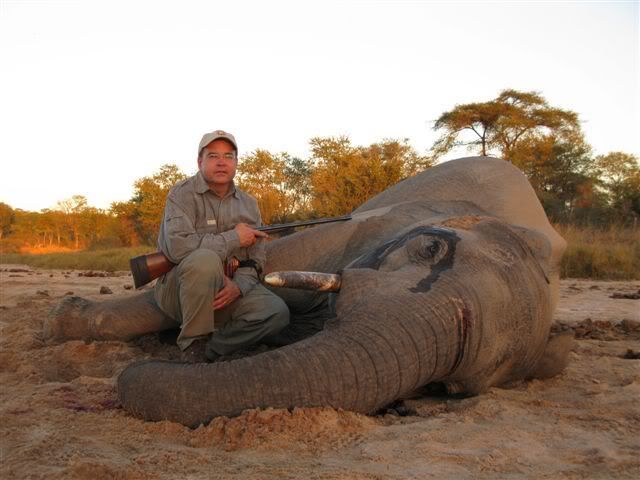
The difference in effect between the .500 and other larger calibers (last year I used a .458 Win Mag) is staggering. The larger diameter bullet coupled with the increased bullet weight have a discernable difference in terms of impact on the animal. All five elephant that I shot with the .500 dropped as if they had been pole axed. On two of the five we actually observed brain matter coming out of the ears. I am a believer in the .500.
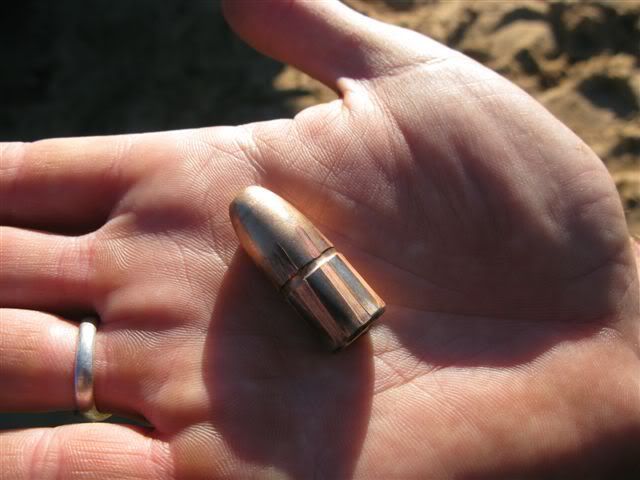
Elephant 4:
Our fourth elephant was our bull. We received a radio call from Rex Hoets (Bill’s professional hunter) and Bill that they had found a nice track. After looking the track over Buzz decided that we should give it a go.
It turned out that we were actually tracking two bulls. The two bulls moved into a thick jesse area and we proceeded to give chase. Eventually we caught up with the bulls. Buzz could see them, although I have to say that I could see little more than patches and bushes. Buzz indicated that one bull was significantly better than the other and that we should try and take it. About that same time, the wind shifted and the bulls moved off slightly to our right.
As the bulls moved off, we attempted to follow. After a short distance they stopped and one of the bulls turned to face us. Rounding the corner of some jesse, Buzz told me to fire and I fired at the bull facing us, ears extended, head up. The bull dropped at twelve paces. When we walked up to the bull, Buzz immediately knew what had happened. The smaller of the two bulls had shifted position with the larger bull and we had been confronted by the smaller bull. That, as they say, is hunting. While I would have loved to have had a shot at the larger bull, sometimes fate deals you a different set of cards. That said, I am thrilled with my trophy hunted the right way.
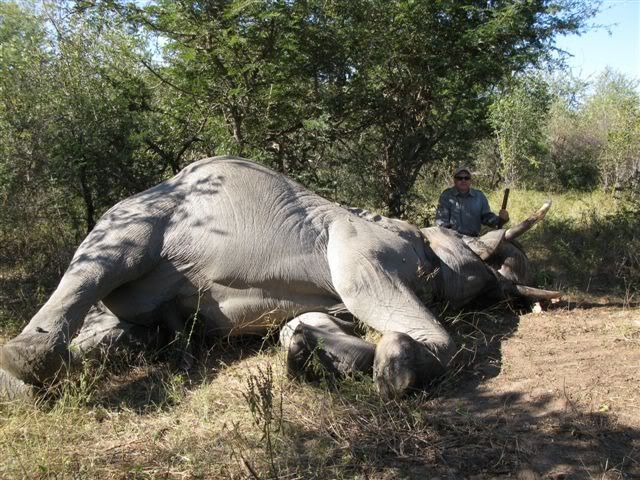


Elephant 5:
On the last day of hunt, the warden confirmed that they wanted us to take another ration elephant. Who could have imagined that a hunt for two elephant would become a hunt for five elephant. If ever there was a case of being in the right place at the right time this was it. The .500 was receiving a test and then some.
In the morning we tracked a group of cows for several hours. We got on them on three occasions but not long enough to ensure that we had a non-trophy bull or a cow without a dependant calf in the group. The herd was aware of our presence and with each shift in the wind, they were off. We finally abandoned the chase and set about to locate another group.
From atop a hill we spotted a group of cows in the jesse in the valley. We began a hike down a gorge to intercept them. This part of the hunt actually reminded me of last year’s hunt in Makuti, lots of up and down over rocky terrain. Eventually we met up with the group and began our stalk. The jesse made it difficult to see anything other than the occasional cow. Finally we located a cow on the right side of the herd. We moved into position and began our approach. At fifteen paces, the cow was clearly aware of our presence. Believing that the cow was about to bolt, Buzz told me to shoot. I fired and the cow collapsed in the classic brain shot fashion: back legs fold, front legs collapse. For the first time on any of the seven elephant I had shot, the elephant actually landed upright as opposed to on its side.

Final Impressions:
What a memorable hunt. Five elephant in fourteen days. Over that time period we saw hundreds of elephant and were in and amongst elephant every single day. Buzz and his team, Criton, Eddy and Justin, worked hard from the first hour of the hunt to the last hour of the hunt. HHK’s camp and camp staff were wonderful hosts. The .500 double performed majestically and demonstrated that so long as you can shoot it, there really is no such thing as “too much gun.†Zimbabwe and its people hold a special place in my heart and I will return for so long as I am able. I pray the situation in Zimbabwe improves, the people deserve better than their current situation.




